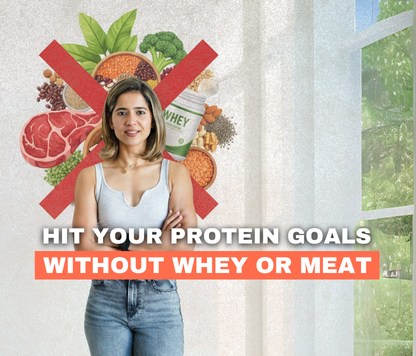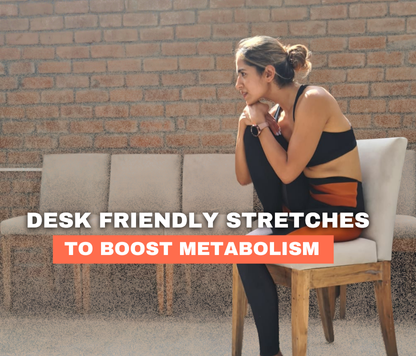No Whey? No Meat? No Problem
For many fitness beginners and busy professionals, meeting daily protein requirements can feel like a chore—especially when you want to avoid whey powders or meat. But here’s the good news: you can absolutely thrive on plant-based and dairy protein sources without compromising your health or fitness progress.
In this blog, we’ll walk you through exactly how to hit your protein goals without whey or meat, combining real food, smart nutrition, and lifestyle habits that actually work. Whether you’re on a high protein vegetarian diet plan for muscle gain or you’re simply trying to eat cleaner, this is your guide.

Why Protein Is Essential For Fitness & Energy
Protein is your body’s primary recovery and repair tool. It plays a major role in muscle growth, metabolic health, and satiety—all vital for fat loss and strength.
When you work out (even lightly), your muscles undergo micro-tears. Protein supplies the amino acids necessary to repair and rebuild them. It also helps maintain lean muscle mass, boost your metabolism, and prevent energy crashes.
That’s why every fitness journey—whether weight loss or strength building—needs protein.
Why Skip Whey Or Meat?
Whey protein may be convenient, but it’s not always ideal. Some people experience bloating, acne, or digestive issues. Meat, especially red or processed types, has been linked to inflammation, higher cholesterol, and long-term health risks like heart disease.
For anyone focusing on longevity, digestion, or simply wanting to explore a cleaner diet, learning how to hit your protein goals without whey or meat is a smart, sustainable move.
Best Plant-Based Protein Sources
Here’s where the magic happens: whole, real, plant-powered foods.
- Lentils & Beans: Packed with protein and fiber, great for meal prep.
- Tofu, Tempeh & Edamame: All from soy, a complete protein with all essential amino acids.
- Chia & Flax Seeds: High in omega-3s, great for metabolism and inflammation.
- Quinoa: A complete protein grain, perfect as a rice substitute.
- Almonds, Peanuts & Nut Butters: Add healthy fats and moderate protein.
- Spirulina: A powerful algae protein packed with antioxidants.
Together, these make up some of the best plant-based protein foods for beginners.
Best Dairy Protein Options (If You Include Dairy)
- Greek Yogurt: Rich in BCAAs and probiotics for gut health.
- Cottage Cheese: High protein, low fat, excellent post-workout snack.
- Milk: Naturally rich in complete protein, calcium, and vitamin D.
These are ideal dairy-free protein sources for weight loss if you opt for lactose-free versions or simply want to cut back on animal meat.
Combining Foods for Maximum Protein Absorption
If you’re aiming for optimal amino acid intake without meat or whey, combine:
- Legumes + Whole Grains: (e.g., lentils + brown rice)
- Tofu + Quinoa Bowls
- Chia Pudding + Greek Yogurt (if including dairy)
This strategy balances essential amino acids and promotes better muscle recovery.
Sample High Protein Vegetarian Diet Plan For Muscle Gain
Breakfast:
Overnight oats with chia seeds, almond butter, and soy milk
Lunch:
Quinoa salad with chickpeas, tofu cubes, and tahini dressing
Snack:
Handful of almonds and a bowl of Greek yogurt
Dinner:
Stir-fried tempeh with brown rice and steamed broccoli
Total: ~80–100g protein without whey or meat.
A Gentle Pitch (The Veg Protein Fix Plan)
If you want a ready-to-follow roadmap with recipes, shopping lists, and simple swaps that work for your routine, check out FitChef by Shitija’s “The Veg Protein Fix” plan.
It’s designed for busy professionals who want results without complicated diets. You’ll get:
- Structured vegetarian meal plans
- Muscle recovery guidance
- Drinking water before Natural protein alternatives to whey meal
Perfect for those serious about wellness, without getting overwhelmed.
Long-Term Benefits of Skipping Whey and Meat
Tracking small changes in how you feel and function keeps motivation alive.
- Improved digestion and fewer bloating issues
- Lower inflammation and joint pain
- Sustainable weight management
- Reduced risk of chronic disease
- Enhanced energy and recovery
These benefits aren’t just theoretical. Thousands of people are making the shift successfully and seeing long-term results.
Final Thoughts
Knowing how to hit your protein goals without whey or meat isn’t just about what you remove, it’s about what you add: variety, balance, and smart choices. With the right combination of plant-based and dairy protein sources, even busy professionals can build strength, boost metabolism, and feel energized every day.
Try it. Stick to it. And if you want that extra nudge, let The Veg Protein Fix guide the way.
Frequently Asked Questions (FAQs)
1. Can I build muscle without whey protein or meat?
Absolutely. You can use high-protein vegetarian foods like soy, lentils, quinoa, and dairy (if you include it). Smart combinations and consistency matter more than your protein source.
2. What are natural protein alternatives to whey?
Some of the best options include tofu, tempeh, Greek yogurt, lentils, seeds, and spirulina. These are excellent for fitness beginners and don’t rely on supplements.
3. What is the best plant-based protein for busy professionals?
Tofu, tempeh, and lentils are quick to prepare and meal-prep-friendly. Chia seeds and oats are great for grab-and-go meals too.
4. How much protein do I need daily without meat or whey?
Most active individuals need 1.2 to 2g per kg of body weight. It’s easily achievable with plant and dairy sources through consistent meals.
5. Is a high protein vegetarian diet plan for muscle gain safe?
Yes—as long as you include a variety of protein-rich foods, balance your meals, and ensure enough calories, it’s completely safe and effective.





